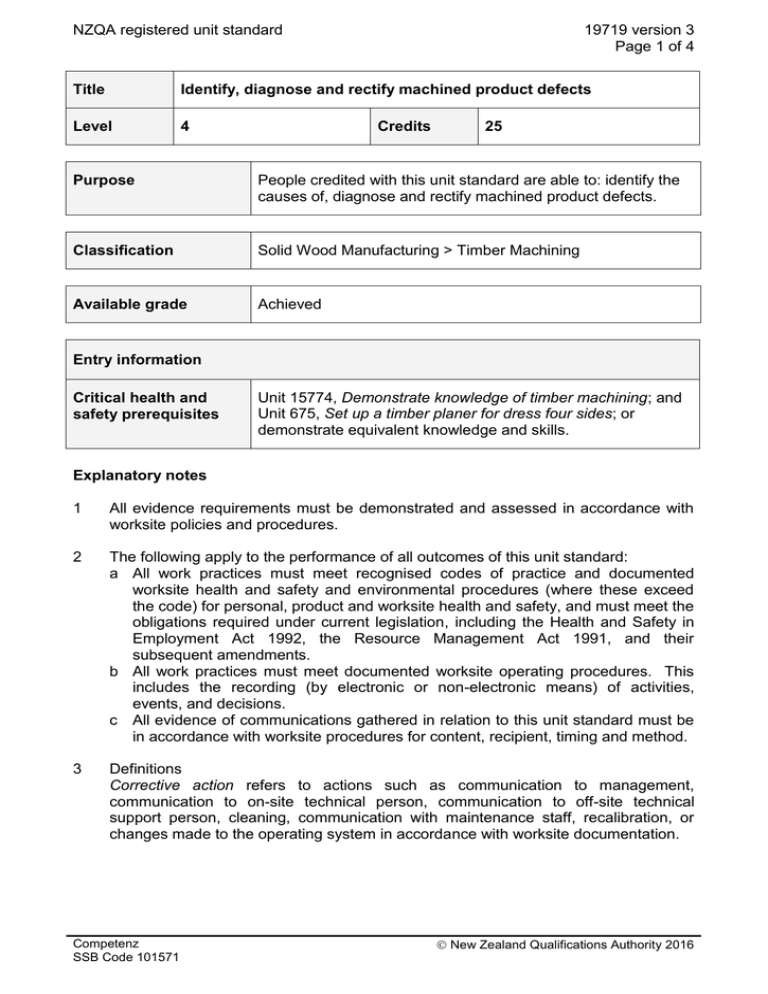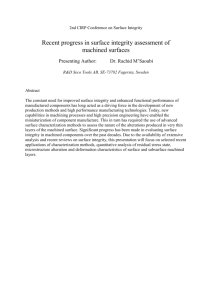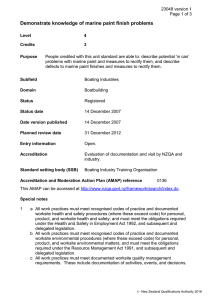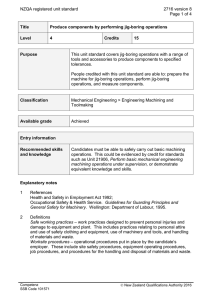NZQA registered unit standard 19719 version 3 Page 1 of 4
advertisement

NZQA registered unit standard 19719 version 3 Page 1 of 4 Title Identify, diagnose and rectify machined product defects Level 4 Credits 25 Purpose People credited with this unit standard are able to: identify the causes of, diagnose and rectify machined product defects. Classification Solid Wood Manufacturing > Timber Machining Available grade Achieved Entry information Critical health and safety prerequisites Unit 15774, Demonstrate knowledge of timber machining; and Unit 675, Set up a timber planer for dress four sides; or demonstrate equivalent knowledge and skills. Explanatory notes 1 All evidence requirements must be demonstrated and assessed in accordance with worksite policies and procedures. 2 The following apply to the performance of all outcomes of this unit standard: a All work practices must meet recognised codes of practice and documented worksite health and safety and environmental procedures (where these exceed the code) for personal, product and worksite health and safety, and must meet the obligations required under current legislation, including the Health and Safety in Employment Act 1992, the Resource Management Act 1991, and their subsequent amendments. b All work practices must meet documented worksite operating procedures. This includes the recording (by electronic or non-electronic means) of activities, events, and decisions. c All evidence of communications gathered in relation to this unit standard must be in accordance with worksite procedures for content, recipient, timing and method. 3 Definitions Corrective action refers to actions such as communication to management, communication to on-site technical person, communication to off-site technical support person, cleaning, communication with maintenance staff, recalibration, or changes made to the operating system in accordance with worksite documentation. Competenz SSB Code 101571 New Zealand Qualifications Authority 2016 NZQA registered unit standard 19719 version 3 Page 2 of 4 Worksite policies and procedures refer to documented policies and to documented or other directions provided to staff. These include, but are not limited to, ways of managing health and safety, environmental considerations, quality, and production, and must conform to legislation. Examples include standard operating procedures, company health and safety plans, on-site briefings, and supervisor’s instructions. Outcomes and evidence requirements Outcome 1 Identify the causes of machined product defects. Evidence requirements 1.1 Raw material characteristics influencing final product quality are identified from supplied samples and explained. Range characteristics include– moisture content, grade, tree age, species, grain. 1.2 The process of monitoring and controlling product quality is explained. 1.3 Machine operating faults that influence final machined product quality are identified from supplied samples and explained. Range 1.4 Machine set-up factors that affect final machined product quality are identified from supplied samples and explained. Range 1.5 faults include – wear, feed issues, broken parts, alignment, operating speeds. A minimum of 10 samples is required. factors include – setting up of feed system, bed, fence plates, cutterheads, pressures, chip breakers, in-feed, out-feed systems. Product defects relating to cutter grinding and preparation are identified from supplied samples and explained. Range cutter setting, cutter grinding, grinding wheel specification, cutter balance, cutter jointing. Outcome 2 Diagnose machined product defects. Range defects identified in a production situation. Competenz SSB Code 101571 New Zealand Qualifications Authority 2016 NZQA registered unit standard 19719 version 3 Page 3 of 4 Evidence requirements 2.1 Raw material product defects are determined. Range 2.2 Machine operating faults causing defective machined product are diagnosed. Range 2.3 may include but is not limited to – machine wear, damage. Machine set-up factors causing a defective machined product are diagnosed. Range 2.4 may include but is not limited to – moisture content, grade-related defects, irregular dimensions, mechanical damage prior to machining. may include but is not limited to – incorrect calibration, alignment, adjustments, cutter grinding, cutter setting, grinding wheel specifications, feed speeds. The process for diagnosing the cause of defective machined product is described. Outcome 3 Rectify machined product defects. Range defects rectified in a production situation. Evidence requirements 3.1 Corrective action is implemented in accordance with worksite policies and procedures, to rectify raw materials product defects. Range 3.2 Corrective action is implemented to rectify machine operating faults causing defective machined product. Range 3.3 defects may include but are not limited to – moisture content, grade, dimensions, mechanical damage prior to machining. defects may include but are not limited to – wear, damage. Corrective action is implemented to rectify machine set-up factors causing defective machined product. Range set-up factors may include but are not limited to – calibration, alignment, machine set-up. 3.4 All tasks are carried out using safe work practices. 3.5 Equipment and work area are left clean, clear and tidy. 3.6 Communication, and recording or reporting, is carried out. Competenz SSB Code 101571 New Zealand Qualifications Authority 2016 NZQA registered unit standard Planned review date 19719 version 3 Page 4 of 4 31 December 2015 Status information and last date for assessment for superseded versions Process Version Date Last Date for Assessment Registration 1 27 December 2002 31 December 2012 Review 2 18 December 2006 31 December 2012 Review 3 15 April 2011 N/A Consent and Moderation Requirements (CMR) reference 0173 This CMR can be accessed at http://www.nzqa.govt.nz/framework/search/index.do. Please note Providers must be granted consent to assess against standards (accredited) by NZQA, before they can report credits from assessment against unit standards or deliver courses of study leading to that assessment. Industry Training Organisations must be granted consent to assess against standards by NZQA before they can register credits from assessment against unit standards. Providers and Industry Training Organisations, which have been granted consent and which are assessing against unit standards must engage with the moderation system that applies to those standards. Requirements for consent to assess and an outline of the moderation system that applies to this standard are outlined in the Consent and Moderation Requirements (CMRs). The CMR also includes useful information about special requirements for organisations wishing to develop education and training programmes, such as minimum qualifications for tutors and assessors, and special resource requirements. Comments on this unit standard Please contact the Competenz info@competenz.org.nz if you wish to suggest changes to the content of this unit standard. Competenz SSB Code 101571 New Zealand Qualifications Authority 2016




